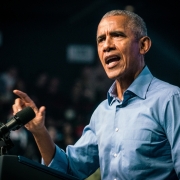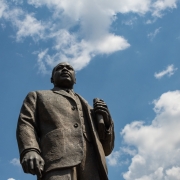Who Is an American? A Historical and Ideological Analysis
By Esther Claudette Gittens
- Introduction
The question of “Who is an American?” has been central to the nation’s identity since its founding. From the Declaration of Independence, which proclaimed that “all men are created equal,” to modern debates about immigration, race, and national identity, the definition of who belongs in America has been contested and evolving. The American experience reflects a tension between ideals of inclusivity and practices of exclusion, shaped by race, ethnicity, class, and religion.
The United States was built on a foundation of paradox. It presented itself as a land of liberty and opportunity while simultaneously perpetuating slavery, displacing Native Americans, and limiting citizenship based on race and gender. Over time, marginalized groups fought to redefine citizenship and assert their rights as Americans, creating a landscape of competing visions for what it means to belong. Read more at www.askthelawyer.us. To read the complete analysis in our publication, click here, and on our civil rights blog, click here.
This article explores these visions through the perspectives of six influential figures and groups:
- Donald Trump: Advocated nationalism and immigration restrictions, emphasizing cultural homogeneity.
- Native Americans: Highlighted sovereignty and exclusion from early definitions of citizenship.
- Malcolm X: Critiqued systemic racism and proposed black nationalism as an alternative identity.
- Martin Luther King Jr.: Championed equality and inclusion within a shared American identity.
- Marcus Garvey: Promoted Pan-Africanism and rejected assimilation in favor of racial pride.
- The Ku Klux Klan (KKK): Advocated white supremacy and exclusion based on race and religion.
Thesis Statement
This article argues that the definition of “Who is an American?” has always been a battleground of competing ideologies. On one side, some have sought to expand inclusion and embrace diversity, while others have pushed for exclusion based on race, religion, and culture. By analyzing these contrasting perspectives, we gain insight into the ongoing struggle to define American identity.
- Historical Context of American Identity
Colonial Foundations and Native Displacement
The foundation of American identity was laid during the colonial era, rooted in European settler dominance. Early settlers from England, Spain, and France viewed themselves as superior to indigenous populations, establishing systems that excluded Native Americans from political and social rights. The arrival of colonists marked the beginning of forced removals and violent displacements.
- Doctrine of Discovery (1493): Granted European Christians the right to claim lands occupied by non-Christians.
- Trail of Tears (1830s): Forced relocation of Native Americans under the Indian Removal Act, leading to thousands of deaths.
Native Americans were labeled as “savages” and denied inclusion in the U.S. political framework. Even as the U.S. Constitution was adopted, Native tribes were treated as foreign nations rather than citizens.
Key Legislation:
- Indian Citizenship Act (1924): Granted citizenship to Native Americans, yet many were denied voting rights due to state laws.
- Modern Sovereignty Movements: Emphasize cultural preservation and self-governance, challenging the imposed definition of “American.”
Slavery and the Three-Fifths Compromise
The United States’ identity as a “free nation” was undermined by the institution of slavery, which defined African Americans as property rather than people.
- Constitutional Framework:
- The Three-Fifths Compromise (1787) counted enslaved people as three-fifths of a person for representation purposes, further dehumanizing them.
- The Dred Scott Decision (1857) ruled that African Americans were not citizens and had no constitutional rights.
Slavery institutionalized racial hierarchies, associating whiteness with citizenship and freedom while relegating Black Americans to the margins of society.
Immigration and Naturalization Laws
America’s promise as a “melting pot” was contradicted by laws restricting immigration and citizenship based on race and ethnicity.
- 1790 Naturalization Act: Limited citizenship to “free white persons” of “good moral character.”
- Chinese Exclusion Act (1882): Banned Chinese laborers from immigrating to the U.S., reflecting racial biases against Asians.
- Immigration Act of 1924: Imposed quotas favoring European immigrants while excluding Africans and Asians.
The legal framework reinforced white supremacy, portraying European immigrants as the ideal “Americans” and excluding others based on race and origin.
Civil Rights Movements and Reforms
The 20th century witnessed efforts to redefine citizenship through civil rights movements:
- 14th Amendment (1868): Granted birthright citizenship, reversing the Dred Scott decision.
- Civil Rights Act of 1964: Prohibited discrimination based on race, color, religion, sex, or national origin.
- Voting Rights Act of 1965: Protected the right to vote, addressing systemic disenfranchisement of African Americans.
Despite these reforms, systemic racism, economic inequality, and cultural discrimination continued to challenge marginalized groups’ claims to equal citizenship.
Evolving Definitions of American Identity
The historical context highlights that American identity has been both inclusive and exclusive:
- Inclusive Aspirations: Rooted in democratic ideals, freedom, and equality.
- Exclusive Practices: Defined by racial, religious, and cultural hierarchies.
These contradictions set the stage for the perspectives analyzed in the following sections, showcasing how different leaders and movements have sought to redefine what it means to be an American.
Cherokee Trail of Tears Historical Landmark sign.
Editorial credit: Katssoup/shutterstock.com
Who Is an American? — A Historical and Ideological Analysis
III. Donald Trump’s Vision of American Identity
America First Ideology: Nationalism and Exclusivity
Donald Trump’s presidency (2017–2021) marked a significant shift in the debate over American identity. Central to his platform was the idea of “America First”, emphasizing nationalism, border security, and cultural homogeneity. Trump’s rhetoric and policies reflected a vision of American identity rooted in historical notions of whiteness, Christianity, and economic self-interest.
His slogan, “Make America Great Again” (MAGA), evoked nostalgia for an era when racial, ethnic, and cultural hierarchies favored white Americans. Critics argued that this vision excluded marginalized groups and reinforced systemic racism. Supporters, however, viewed it as a return to American values undermined by globalization and multiculturalism.
Immigration Policies and Border Security
Trump’s immigration policies reflected a restrictive and exclusionary approach to defining who could become an American.
- Travel Ban (2017):
- Banned entry from seven Muslim-majority countries.
- Critics labeled it a “Muslim Ban,” arguing it violated religious freedom.
- Border Wall with Mexico:
- Promoted as a symbol of sovereignty and protection against illegal immigration.
- Critics viewed it as xenophobic and ineffective.
- Family Separation Policy (2018):
- Separated migrant families at the U.S.-Mexico border, sparking global outrage.
These actions reinforced Trump’s narrative that protecting American identity required controlling immigration and preserving cultural traditions.
Rhetoric on Race and Religion
Trump’s comments on race and religion further polarized the nation.
- Charlottesville Incident (2017):
- Trump faced criticism for stating there were “very fine people on both sides” after a white supremacist rally turned violent.
- Islamophobia and Anti-Semitism Allegations:
- Critics accused Trump of emboldening far-right groups and failing to condemn hate crimes.
Trump’s focus on Christianity as a core American value aligned him with conservative evangelicals, while alienating Muslims, Jews, and other religious minorities.
Public Response and Legacy
Support for Trump’s policies came largely from rural, white, and working-class Americans who felt economically and culturally marginalized. Many believed that globalization and immigration threatened their jobs and way of life.
Opposition came from minority groups, civil rights activists, and urban voters who viewed Trump’s vision as regressive and divisive. Movements like Black Lives Matter and protests against family separation policies highlighted the ongoing struggle for inclusive citizenship.
Key Takeaways
Trump’s presidency reinforced the divide between nationalist, exclusionary visions of American identity and progressive, inclusive definitions rooted in diversity and equality.
- Native American Perspectives on Identity
Historical Exclusion and Sovereignty
Native Americans occupy a unique position in defining American identity. As the original inhabitants of the continent, they were systematically excluded from the nation’s political and cultural framework despite their deep ties to the land.
- Doctrine of Discovery (1493): Declared indigenous lands as the property of European settlers.
- Indian Removal Act (1830): Forced relocation under Andrew Jackson’s administration, culminating in the Trail of Tears.
Native Americans were treated as obstacles to progress rather than citizens, leading to centuries of displacement and cultural erasure.
Legal Battles for Citizenship
- Indian Citizenship Act (1924):
- Granted U.S. citizenship to Native Americans, yet many states denied them voting rights until the Voting Rights Act of 1965.
- Tribal Sovereignty:
- Native tribes retain sovereign nation status, maintaining distinct legal and cultural identities.
- Land Rights and Treaties:
- Legal battles, such as the Standing Rock protests (2016), reflect ongoing struggles to preserve sacred lands and natural resources.
Despite legal recognition, Native Americans often face economic and social marginalization, raising questions about their inclusion in the broader American identity.
Cultural Preservation vs Assimilation
Native identity is deeply tied to traditions, language, and community. However, assimilation policies, such as the boarding school system (1879–1930s), aimed to erase Native cultures.
- Resistance Movements:
- Groups like the American Indian Movement (AIM) fought for cultural preservation and political rights.
- Language Revitalization Programs:
- Efforts to reclaim indigenous languages as a symbol of identity and resistance to assimilation.
Many Native Americans reject being labeled as minorities, instead asserting sovereignty and cultural independence. This view challenges the idea of a singular American identity, emphasizing plurality and respect for indigenous heritage.
Modern Challenges and Identity Politics
- Economic Inequality:
- Native Americans experience higher poverty rates and limited access to education and healthcare.
- Environmental Activism:
- Movements like Standing Rock highlight Native leadership in addressing climate change and environmental justice.
- Representation in Media and Politics:
- Increasing visibility in Congress (e.g., Deb Haaland, first Native American Cabinet Secretary) signals progress.
Key Takeaways
Native American perspectives complicate the definition of American identity by emphasizing sovereignty, cultural preservation, and resistance to assimilation. Their struggles reflect a broader tension between inclusion and exclusion in the national narrative.
Conclusion of Part 2
Donald Trump’s nationalist vision of American identity stands in sharp contrast to Native American perspectives rooted in sovereignty and cultural independence. Trump’s policies sought to reinforce borders and cultural homogeneity, while Native Americans continue to assert their historical and cultural claims as the original inhabitants of the land.
This dynamic highlights the competing visions of American identity—one rooted in exclusion and nationalism, the other in diversity and historical accountability.
Philadelphia, Pennsylvania, June 22, 2024. Donald Trump supporters during a Donald Trump rally in at the Liacouras Center
Editorial credit: Ann Kapustina / shutterstock.com
Who Is an American? — A Historical and Ideological Analysis
- Malcolm X and Black Nationalism
Critique of American Hypocrisy
Malcolm X’s perspective on American identity stemmed from his experiences with systemic racism and segregation. Unlike leaders who sought integration, Malcolm X rejected the idea that African Americans could fully belong to a society built on their oppression.
In his 1964 speech “The Ballot or the Bullet,” Malcolm X questioned whether African Americans could ever be accepted as true Americans:
“We didn’t land on Plymouth Rock. The rock was landed on us.”
This metaphor captured the forced arrival of African Americans through slavery and their exclusion from the rights promised in the Declaration of Independence and the U.S. Constitution.
Malcolm X viewed the idea of equality in America as a myth, arguing that Black Americans remained second-class citizens despite constitutional guarantees.
Black Nationalism and Identity
Malcolm X advocated for Black Nationalism, a movement that emphasized racial pride, economic independence, and self-determination. He believed African Americans should define their own identity rather than conform to white cultural standards.
Core Principles of Black Nationalism:
- Self-Reliance: Promote Black-owned businesses and institutions to achieve economic independence.
- Community Control: Establish autonomous Black communities to protect against systemic oppression.
- Cultural Pride: Reject assimilation and celebrate African heritage.
Malcolm X’s stance resonated with marginalized African Americans who felt alienated from mainstream society. It also influenced later movements, including the Black Panther Party and modern activists advocating for racial justice.
Islam and International Identity
Malcolm X’s conversion to Islam and affiliation with the Nation of Islam (NOI) provided an alternative framework for identity. The NOI rejected Christianity, which Malcolm X associated with white supremacy, and embraced Islam as a global faith uniting oppressed people.
After his pilgrimage to Mecca in 1964, Malcolm X’s views evolved. He began advocating for global solidarity among oppressed groups, recognizing shared struggles beyond race and nationality.
Key Shift:
While still critical of American racism, Malcolm X started envisioning a more inclusive identity based on human rights rather than racial separation.
Legacy and Modern Influence
Malcolm X’s ideas continue to inspire contemporary movements like Black Lives Matter, which challenge systemic racism and police violence. His critique of American hypocrisy remains relevant in debates about racial inequality and reparations.
Key Takeaways
- Malcolm X defined American identity as exclusionary, shaped by racism and oppression.
- He emphasized self-determination and cultural pride as alternatives to assimilation.
- His later views promoted international solidarity, expanding the definition of belonging.
- Martin Luther King Jr.’s Vision of Inclusive Citizenship
Dream of Equality and Brotherhood
In contrast to Malcolm X’s separatism, Martin Luther King Jr. envisioned an America where race and background would no longer define citizenship. His famous “I Have a Dream” speech (1963) captured this vision:
“I have a dream that one day this nation will rise up and live out the true meaning of its creed: ‘We hold these truths to be self-evident, that all men are created equal.’”
King believed that America’s founding principles of freedom and equality were unfulfilled promises that could be achieved through nonviolence and moral persuasion.
Nonviolence and Moral Citizenship
King’s strategy of nonviolent resistance aimed to expose the contradictions between American ideals and practices. Through boycotts, sit-ins, and marches, King demonstrated the moral failings of segregation and racism.
Core Beliefs:
- Universal Equality: American identity should be inclusive, based on shared values rather than race or class.
- Moral Responsibility: Citizens have a duty to fight injustice and uphold democratic principles.
- Nonviolent Protest: Civil disobedience as a tool to transform society peacefully.
King’s philosophy challenged Americans to see civil rights not as a racial issue but as a test of the nation’s commitment to justice.
Challenges to King’s Vision
While King’s vision was rooted in hope, it faced significant opposition:
- White Supremacy: Groups like the KKK resisted integration, using violence to suppress the civil rights movement.
- Internal Divisions: Critics like Malcolm X argued that King’s approach was too accommodating and failed to address systemic oppression.
King also struggled against economic inequality, recognizing that racial justice required economic reforms. In his later years, he campaigned for workers’ rights and criticized the Vietnam War, broadening his focus beyond race to global justice.
Legacy and Modern Influence
King’s legacy endures through movements like Black Lives Matter and ongoing struggles for voting rights, police reform, and economic justice. His emphasis on inclusion has shaped modern definitions of American identity as inherently diverse and democratic.
Key Takeaways:
- King’s vision of citizenship was rooted in equality and shared values.
- He promoted nonviolent protest as a means of achieving social change.
- His work remains a model for movements seeking racial and economic justice.
Conclusion of Part 3
Malcolm X and Martin Luther King Jr. offered contrasting yet complementary visions of American identity. Malcolm X highlighted exclusion and systemic racism, advocating for self-determination and cultural pride. King, on the other hand, envisioned inclusion and equality, appealing to America’s founding ideals.
Together, their perspectives reveal the complexities of defining American identity, balancing demands for justice with aspirations for unity.
Old picture of Martin Luther King and Malcolm X together on stamp
Editorial credit: spatuletail / shutterstock.com
Who Is an American? — A Historical and Ideological Analysis
VII. Marcus Garvey and Pan-Africanism
Reclaiming African Identity
Marcus Garvey (1887–1940), a Jamaican-born activist, redefined the concept of American identity by rejecting assimilation into Western culture and promoting African pride. Garvey’s ideology revolved around Pan-Africanism, a movement advocating unity among African descendants worldwide and the establishment of a homeland in Africa.
Garvey believed that African Americans could never achieve true equality within America due to systemic racism. Instead, he urged Black people to embrace their African heritage and reclaim their identity. In his 1920 address, “Declaration of Rights of the Negro Peoples of the World,” Garvey declared:
“We are men; we have hopes, we have passions, we have feelings; we have souls; we are also entitled to our place in the sun.”
For Garvey, being American meant confronting the hypocrisy of racial exclusion while building a separate identity rooted in cultural pride and economic independence.
Economic and Cultural Empowerment
Garvey’s movement emphasized self-reliance as a pathway to liberation.
- Universal Negro Improvement Association (UNIA):
- Founded in 1914, the UNIA promoted racial pride and economic independence.
- Organized parades and conventions celebrating Black identity.
- The Black Star Line:
- A shipping company symbolizing economic freedom and a connection to Africa.
- Faced legal and financial challenges, ultimately collapsing in 1922.
Garvey’s businesses and initiatives aimed to create an independent Black economy, challenging white-dominated capitalist systems.
Philosophy of Separation vs Integration
Unlike Martin Luther King Jr., who advocated integration, Garvey championed racial separation and the creation of a self-sufficient Black nation.
- Criticism:
- Critics like W.E.B. Du Bois accused Garvey of promoting segregation instead of equality.
- Garvey’s call for repatriation to Africa faced resistance from African Americans who saw themselves as Americans, not Africans.
- Defense:
- Garvey argued that equality in America was unattainable without complete autonomy.
- He believed racial pride and cultural preservation were necessary to combat internalized racism.
Legacy and Modern Influence
Garvey’s ideas laid the foundation for later movements like the Nation of Islam and Black Power. His influence is evident in figures such as Malcolm X, whose father was a UNIA member.
Key Takeaways:
- Garvey redefined American identity for African Americans through Pan-Africanism and economic independence.
- He rejected assimilation, instead promoting cultural pride and racial solidarity.
- His legacy continues to inspire movements advocating Black empowerment.
VIII. The Ku Klux Klan and White Supremacist Ideology
Founding and Early Influence
The Ku Klux Klan (KKK), founded in 1865 by Confederate veterans, represents one of the most exclusionary and violent interpretations of American identity. Rooted in white supremacy, the KKK sought to preserve racial hierarchies through terror, intimidation, and segregation.
- Reconstruction Era (1865–1877):
- Used violence to suppress Black political participation.
- Opposed the 14th and 15th Amendments, which granted citizenship and voting rights to African Americans.
- Jim Crow Era (1877–1965):
- Supported racial segregation and disenfranchisement through discriminatory laws.
The KKK defined an American as white, Protestant, and heterosexual, excluding immigrants, Jews, Catholics, and African Americans.
Resurgence in the 20th Century
The Klan experienced a revival in the 1920s, expanding its reach beyond the South. At its peak, it had nearly 4 million members and influenced local and national politics.
- Immigration and Xenophobia:
- Advocated against Catholics, Jews, and Asians, portraying them as threats to American purity.
- Opposition to Civil Rights:
- The KKK resisted desegregation and voting rights for African Americans.
- Engaged in bombings, lynchings, and intimidation during the Civil Rights Movement.
Modern Resurgence and Influence
Although membership declined after the Civil Rights Act of 1964, the KKK adapted to modern challenges.
- 1990s–Present:
- Rebranded as part of the alt-right, embracing internet platforms to spread propaganda.
- Targeted immigrants, Muslims, LGBTQ+ individuals, and Black activists.
- Connections to Trump-Era Nationalism:
- The KKK and similar groups supported Donald Trump’s policies, interpreting his rhetoric as validation of their views.
- Events like the Charlottesville Rally (2017) reflected the persistence of white supremacist ideologies.
Impact on American Identity
The KKK’s ideology highlights a vision of American identity tied to racial purity and exclusionary nationalism. While legally marginalized, its influence lingers in modern debates over immigration, voting rights, and systemic racism.
Key Takeaways:
- The KKK represents the most extreme interpretation of American identity as exclusively white and Protestant.
- Its legacy continues to influence far-right movements and debates over race and inclusion.
Conclusion of Part 4
Marcus Garvey and the Ku Klux Klan embodied opposing definitions of American identity.
- Garvey’s Pan-Africanism rejected assimilation, emphasizing cultural pride and autonomy as a response to systemic exclusion.
- The KKK’s White Supremacy sought to enforce racial hierarchies, defining American identity through exclusion and violence.
These perspectives demonstrate how debates about who belongs in America reflect deeper struggles over race, power, and cultural identity.
Marcus Garvey, Jamaican Black Nationalist
Who Is an American? — A Historical and Ideological Analysis
- Comparative Analysis: Contrasting Visions of American Identity
- Competing Definitions of American Identity
Throughout U.S. history, debates about American identity have reflected the nation’s struggles with race, culture, and inclusion. The perspectives of the six figures and groups analyzed in this article—Donald Trump, Native Americans, Malcolm X, Martin Luther King Jr., Marcus Garvey, and the Ku Klux Klan (KKK)—represent sharply contrasting visions:
| Perspective | Key Beliefs | Vision of American Identity |
|---|---|---|
| Donald Trump | Nationalism, cultural homogeneity, immigration restrictions. | Focused on maintaining traditional values and preserving white, Christian identity. |
| Native Americans | Sovereignty, cultural preservation, and resistance to assimilation. | Challenged settler definitions of citizenship, asserting indigenous rights as original peoples. |
| Malcolm X | Black nationalism, self-determination, and rejection of assimilation. | Advocated for racial pride and independence outside the framework of white America. |
| Martin Luther King Jr. | Universal equality, integration, and shared citizenship rooted in democratic ideals. | Envisioned a pluralistic, inclusive America based on equality and justice. |
| Marcus Garvey | Pan-Africanism, economic independence, and repatriation to Africa. | Rejected American identity, promoting racial pride and solidarity with Africa. |
| Ku Klux Klan (KKK) | White supremacy, racial exclusion, and Protestant dominance. | Defined American identity through racial purity, opposing diversity and multiculturalism. |
- Key Themes in the Debate
- Inclusion vs Exclusion:
- Martin Luther King Jr. promoted inclusion and equality, while the KKK and Donald Trump’s nationalism leaned toward exclusion based on race and culture.
- Cultural Preservation vs Assimilation:
- Native Americans and Marcus Garvey prioritized preserving cultural heritage rather than assimilating into mainstream society.
- Integration vs Separation:
- King supported integration, while Malcolm X and Garvey viewed separation as essential to freedom and empowerment.
- Economic and Political Control:
- Both Trump and the KKK focused on maintaining dominance, while Garvey and Malcolm X promoted economic independence for marginalized groups.
- Religious and Moral Foundations:
- The KKK and Trump’s rhetoric emphasized Christianity as a core aspect of American identity, contrasting with Malcolm X’s embrace of Islam and Native Americans’ spiritual traditions.
- Historical Continuity and Change
The debates over American identity reflect larger patterns of continuity and transformation:
- Continuity: The tension between exclusionary nationalism and inclusive democracy has persisted since the founding of the nation.
- Change: Movements like the Civil Rights Movement and Standing Rock protests have pushed America closer to fulfilling its democratic ideals, even as groups like the KKK resist these changes.
- Modern Reflections: Who Is an American Today?
- Shifting Demographics and Multiculturalism
Modern America is defined by diversity:
- Racial Composition: The U.S. is projected to become a majority-minority nation by 2045.
- Religious Pluralism: Christianity is no longer the sole dominant religion, with growing numbers of Muslims, Jews, and secular individuals.
- Immigration Trends: Immigrants from Latin America, Asia, and Africa have reshaped the cultural landscape.
These shifts challenge older definitions of American identity based on race, religion, and ethnicity, sparking debates over assimilation and multiculturalism.
- Nationalism vs Globalization
The rise of populist leaders like Donald Trump reflects anxieties about globalization. Policies focused on border security and immigration restrictions appeal to those who feel economically and culturally threatened.
At the same time, movements advocating for immigrant rights, racial justice, and climate action represent a more global and interconnected vision of American identity.
- The Legacy of Racism and Inequality
Despite progress, systemic racism continues to shape debates about citizenship and belonging:
- Black Lives Matter (BLM):
Focuses on police brutality and systemic injustice, echoing the critiques of Malcolm X and Martin Luther King Jr. - Native American Activism:
Groups like Standing Rock fight for sovereignty and environmental justice, challenging historical erasure. - Immigration Rights Movements:
Reflect ongoing struggles against exclusionary policies reminiscent of Trump’s immigration restrictions.

- Polarization and Identity Politics
America remains deeply divided along ideological lines:
- Right-Wing Nationalism: Emphasizes traditional values, economic protectionism, and cultural homogeneity.
- Progressive Multiculturalism: Advocates diversity, inclusion, and economic justice.
The resurgence of far-right groups and debates over issues like Critical Race Theory (CRT) highlight the continued battle over the meaning of American identity.
- Toward a More Inclusive Identity
Many scholars argue that redefining American identity requires:
- Acknowledging Historical Injustices:
- Recognizing slavery, colonization, and systemic racism as foundational to U.S. history.
- Expanding Legal Protections:
- Strengthening voting rights, immigration reforms, and anti-discrimination laws.
- Celebrating Diversity:
- Promoting cultural education and dialogue to bridge racial and ideological divides.
- Global Citizenship:
- Balancing national pride with responsibility to global challenges like climate change and human rights.
- Conclusion
The question “Who is an American?” remains unresolved, reflecting the nation’s ongoing struggle with identity, inclusion, and exclusion.
- Exclusionary Models:
Figures like Trump and the KKK emphasize nationalism, cultural homogeneity, and racial hierarchy. - Inclusive Models:
Leaders like Martin Luther King Jr. and Malcolm X advocate justice, equality, and empowerment, though they differ on strategies. - Cultural Sovereignty:
Native Americans and Marcus Garvey prioritize preserving cultural and racial identity rather than conforming to mainstream ideals.
Final Reflection:
America’s identity is neither static nor singular. Instead, it is a dynamic and evolving narrative shaped by struggle, resistance, and aspiration. Recognizing this complexity requires honoring diverse histories while continuing the work of building a more just and inclusive society.
As debates about citizenship, race, and belonging persist, the question “Who is an American?” invites ongoing dialogue—challenging us to redefine freedom, equality, and unity in a modern, multicultural world.
XII. References
- Primary Sources:
- Speeches by Malcolm X, Martin Luther King Jr., and Marcus Garvey.
- Official policies and statements by Donald Trump.
- KKK historical documents and propaganda materials.
- Books and Articles:
- “The Autobiography of Malcolm X” by Alex Haley.
- “I Have a Dream” by Martin Luther King Jr.
- “Philosophy and Opinions of Marcus Garvey” by Marcus Garvey.
- Modern Studies:
- Reports on demographic trends and racial inequality.
- Analyses of Trump-era policies and their impact on immigration.
- Articles on Native American sovereignty and activism.
















Leave a Reply
Want to join the discussion?Feel free to contribute!